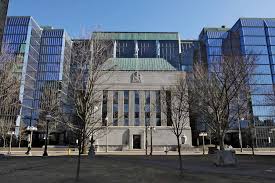Is Canada headed for another rate cut? Economists predict Bank of Canada will slash rates amid economic struggles

bank of Canada
As economic uncertainty deepens, economists widely expect the Bank of Canada (BoC) to deliver another 25-basis-point interest rate cut this week — a move aimed at softening the blow of trade instability, weak business investment, and a cooling labour market.
The upcoming rate decision, scheduled for Wednesday, October 29, could bring the benchmark rate down to 2.25%, nearing the lower end of the central bank’s estimated neutral range. This would mark the second consecutive cut, following September’s reduction from 2.75% to 2.5%.
Economic Pressures Mounting Across Sectors
The Canadian economy continues to show signs of strain. Second-quarter data revealed a 1.6% contraction in GDP, while early indicators suggest sluggish growth in the third quarter as well. Employment numbers, though stable on the surface, reflect underlying weakness. The unemployment rate remains at 7.1%, and job creation has slowed significantly in key industries.
Economists like Jeremy Kronick, vice-president of economic analysis at the C.D. Howe Institute, say the trend is concerning. “We’re seeing broad weakness — and more could come, especially if layoffs persist in major sectors hit by U.S. tariffs,” he said.
Trade Tensions Complicate Canada’s Outlook
Adding to the uncertainty is the reemergence of trade friction between Canada and the United States. Recent tensions flared after U.S. President Donald Trump announced new tariffs and abruptly canceled trade talks, citing a controversial Ontario-funded ad criticizing American tariffs.
The fallout has been immediate. The Canadian auto sector has taken a hit, with Stellantis NV relocating production of its Jeep Compass from Ontario to Illinois and General Motors ending BrightDrop van manufacturing in Ingersoll, Ontario. Such developments have heightened fears of job losses and capital flight from Canada’s manufacturing base.
Economists believe these pressures have tipped the balance in favor of another rate cut. “The latest trade disruptions and auto industry setbacks make a stronger case for monetary easing,” said Douglas Porter, chief economist at the Bank of Montreal (BMO).
Inflation and Policy Dilemma
While inflation rose to 2.4% in September, core inflation remains above 3%. Despite this, policymakers appear more concerned about economic stagnation than rising prices. Porter explained that the risks of job market weakness outweigh the inflation threat, especially as business confidence and investment continue to slide.
A recent Bank of Canada business outlook survey also revealed lower inflation expectations among firms, reinforcing the notion that price pressures are easing naturally.
Limited Impact on Housing and Consumers
Meanwhile, housing markets are showing mixed reactions. In some provinces, rate cuts have had little effect on sales or affordability. Economists like Daren King of the National Bank note that “Canada’s housing market is now regionally fragmented — not one big national market anymore.”
Even with another rate cut, experts like Leah Zlatkin, a mortgage broker with LowestRates.ca, warn that the financial relief for homeowners will be minimal. “For every $100,000 borrowed, a quarter-point cut only saves about $15 a month,” she said.
What Lies Ahead
Most analysts agree that the BoC will continue easing until rates hit around 2%, but further cuts may depend on how trade negotiations and federal spending plans unfold in the coming months. With Ottawa’s fall budget due in early November, policymakers face the challenge of aligning monetary policy with fiscal strategy to support the economy without reigniting inflation.
Economists predict the central bank will accompany its decision with a refreshed Monetary Policy Report, providing clearer guidance on growth, inflation, and Canada’s trade outlook heading into 2026.
FAQ
Q: Why is the Bank of Canada expected to cut interest rates again?
A: Economists anticipate a rate cut to counter economic slowdown driven by weak growth, job losses, and U.S. trade tensions.
Q: How much will the rate drop?
A: A 25-basis-point cut is expected, bringing the policy rate down to 2.25%.
Q: How will this affect homeowners?
A: Those with variable-rate mortgages may see slightly lower monthly payments, but the overall impact will be modest.
Q: What risks remain for the economy?
A: Persistent trade instability, job losses in manufacturing, and regional housing challenges could continue to weigh on growth.
Q: Could more cuts come after this?
A: Yes, but economists believe further cuts will depend on how the federal government’s budget and global trade dynamics evolve.

